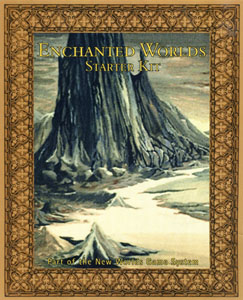This review originally appeared in the October 2000 issue of Games Unplugged.
 Where’s the beef?
Where’s the beef?
I hate to sound so flip, but that’s the question that was bouncing back and forth through my brain as I finished reading through my copy of the Enchanted Worlds: Starter Kit boxed set.
What you get: A slim booklet containing rules and setting information, a half-size booklet with an introductory adventure, a reference sheet, two eight-sided dice, a handful of character sheets, and a full color map.
The system is a standard Attribute + Skill deal, rolled against on 2d8. Character creation involves picking a race and then distribution roughly 250 points across your attributes and skills. Combat is handled using the standard resolution system (contested actions are handled by subtracting the defender’s skill from the attacker’s roll), with damage determined by weapon type and severity (the latter is determined randomly). Magic also relies on the standard resolution mechanic. It’s a simple, clean system – but nothing you haven’t seen a dozen times before. That’s not necessarily a bad thing, but those other systems you’ve seen probably came with more extensive equipment, spell, and skill lists (in other words, more depth and breadth).
The World of Unlond is a standard Tolkienesque fantasy – you’ve got your Dwarves (Earth and Stone), your Elves (Dawn, Twilight, Sun, and Moon), and your humanoids (Goblins and Hobgoblins). You’ve also two or three paragraph descriptions of the various geographical locations of the world (for example, the Eastern Marshes or the Thengold Empire). The “official backdrop” for the game is the Andarian Baronies – for which you are given a column of historical info, two columns of info on the government and society, and a three page overview of the Town of Greenway. The main book wraps itself up with a six page Bestiary (with all your standard fantasy fare – Giant Rats to Goblin Warriors).
The other major component of the boxed set is “Autumn Harvest”, a short introductory adventure. The adventure consists of a farmer asking the PCs for help because a terrible monster (a Giant Spider) has infested his farmhouse and hurt his little girl. Although the cover of the adventure seems to promise some political intrigue (“On the borders of Darkon Andar, a little girl is attacked. Now, you must find out why she was hurt and who or what is protecting the secrets of the past.”), in truth it is just a simplistic and mundane dungeon crawl: You go to the farmhouse, kill some monsters, find a hidden underground complex (consisting of six rooms), and kill some more monsters.
The color map and reference card are both well done – certainly within expectations.
So I ask again: Where’s the beef?
The material found here would make a really good pitch for a fantasy RPG: “We’ve got this good idea for an RPG… here are some rough ideas of the direction we’re thinking of taking.” But it’s not enough. Simply put, there’s no motivation for me to pick up this package.
I live in a world where I can pick up a Hogshead New Style game (and get a comparable number of pages, although of much higher quality and content) for six bucks. I also live in a world where I can pick up the two hundred page Player’s Handbook for D&D (and get a far more complete and well supported fantasy RPG) for twenty bucks. So why am I going to pick up a generic fantasy game which gives me neither a thorough set of rules nor a well-developed background for $14.95?
And I’m afraid the answer is: I’m not.
Grade: D
Writers: Matthew Rodgers and Daniel Price
Publisher: New Worlds Gaming
Price: $14.95
Page Count: 40
Product Code: EWRSK1
After the initial appearance of a review, Games Unplugged would run a short recap of the review in subsequent issues.
Recap: Where’s the beef? I hate to sound so flip, but that’s the question that was bouncing back and forth through my brain as I finished reading my copy of the Enchanted Worlds boxed set. You get a fairly standard system (which doesn’t really go very far beyond the most basic requirements) and an under-developed Tolkienesque fantasy setting.
I live in a world where I can pick up a Hogshead New Style game (and get a comparable number of pages, although of much higher quality and content) for six bucks. I also live in a world where I can pick up the two hundred page Player’s Handbook for D&D (and get a far more complete and well supported fantasy RPG) for twenty bucks. So why am I going to pick up a generic fantasy game which gives me neither a thorough set of rules nor a well-developed background for $14.95?
And I’m afraid the answer is: I’m not.
As I mentioned last week, after unexpectedly receiving review copies of this game I ended up writing two different reviews of it: The one for Games Unplugged that you just read and another for Gaming Outpost, which you can find over here.
Tony Lee, the editor of Games Unplugged, was not happy with the review. He didn’t want to publish a review which was as negative as this one and he asked me to rewrite it. I declined: It was a mediocre game sold in a dress shirt box with an inkjet-printed 8.5 x 11 cover taped on top. I gave it the shitty grade that it deserved. (And to give you some idea of how doomed this game was: The 3rd Edition D&D Player’s Handbook was reviewed in the exact same issue of Games Unplugged.)
The version of the review that was published in the magazine was heavily edited, although my letter grade remained intact.











